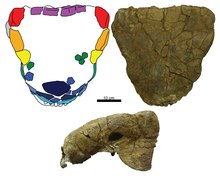无齿甲龙属
| 无齿甲龙属 化石时期:晚白垩世,
| |
|---|---|

| |
| 赖氏无齿甲龙正模标本的颅骨CMN 8530 | |
| 科学分类 | |
| 界: | 动物界 Animalia |
| 门: | 脊索动物门 Chordata |
| 纲: | 蜥形纲 Sauropsida |
| 总目: | 恐龙总目 Dinosauria |
| 目: | †鸟臀目 Ornithischia |
| 科: | †甲龙科 Ankylosauridae |
| 亚科: | †甲龙亚科 Ankylosaurinae |
| 属: | †无齿甲龙属 Anodontosaurus Sternberg, 1929 |
| 模式种 | |
| †赖氏无齿甲龙 Anodontosaurus lambei Sternberg, 1929
| |
| 其他物种 | |
| |
无齿甲龙(属名:Anodontosaurus)是一属已灭绝的甲龙科(甲龙亚科)恐龙,化石发现于加拿大艾伯塔省南部晚白垩世(坎帕阶中晚期至马斯特里赫特阶中期,约7280万至6700万年前)的马蹄谷组,含有两个物种:赖氏无齿甲龙(A. lambei)和起源无齿甲龙(A. inceptus)。[1][2]
发现
[编辑]
无齿甲龙由查尔斯·莫特拉姆·斯腾伯格(Charles Mortram Sternberg)根据正模标本CMN 8530命名,该标本是一具部分完整的骨骼,包括颅骨、颈椎半环(cervical half ring)、装甲和其它颅后骨骼。[3]这具被严重压碎的[1]骨骼是斯腾伯格于1916年从莫林西南8英里处加拿大自然博物馆(Canadian Museum of Nature)的一个采石场中收集。[3]标本发现于下马蹄谷组第二地层带上部,可追溯至大约7100万年前至7020万年前的坎帕阶晚期至马斯特里赫特阶早期。[1][4]属名在希腊语中意为“没有牙齿的蜥蜴”,是指这样一个事实:即对标本损坏导致牙齿缺失,同时移动了颅骨下方和左下颌顶部的各种扁平圆形骨骼结构,令斯腾伯格误以为大型“研磨板”(trituration plates)已取代正常齿列;[5]种名lambei纪念加拿大地质学家和古生物学家、加拿大地质调查局(Geological Survey of Canada,收藏正模标本的机构)研究人员劳伦斯·赖博(Lawrence Morris Lambe)。[3]
库姆斯于1986年检查了AMNH 5266标本。当时,他将其确认为幼年个体并归类于包头龙。标本由五个椎体、一个神经弓、一根背肋、两根骶肋、右坐骨、完整的右后肢、右足、不完整的左足和其它碎片组成。AMNH 5266于1912年在红鹿河(Red Deer River)发现,由巴纳姆·布朗在彼得·凯森、乔治·奥尔森和查尔斯·斯腾伯格的协助下从马蹄谷组的沉积物中收集。[6]
叙述
[编辑]
无齿甲龙是种中型四足陆栖植食性甲龙科。像其它甲龙类一样,无齿甲龙背部覆有盔甲,尾部末端有一个宽而尖的骨槌。颅骨特征为postocular caputegulae――一种多边形的小骨板,存在于眼睛的正后方。
库姆斯支持AMNH 5266是幼年个体的说法,并举出椎体未融合至神经弓、骶肋也没有融合到椎骨和髂骨等证据。支持该观点的其他形态特征包括:①长骨表面光滑,不像成体骨骼那样粗糙特征;②股骨头不呈球形,与股骨干的相邻部分有明显界限;③胫骨、腓骨远端未与距骨和跟骨融合;④手部末节指骨的近端关节末端并不像成体那样宽。
分类学
[编辑]

1971年,沃尔特·库姆斯(Walter Coombs)提出晚白垩世坎帕阶的北美洲只有一种甲龙科,认为无齿甲龙、倍甲龙和刺甲龙皆为包头龙的异名。[7]该结论被普遍接受,因此CMN 8530被归类于包头龙。[5]然而,阿尔博尔等人(2009年)将倍甲龙恢复为有效属之后,[4]在SVP 2010年会议上的摘要中,维多利亚·阿尔博尔(Victoria Arbour)认为无齿甲龙的颅骨形态、颈椎半环装饰、尾槌形态及其尖锐的三角形皮内成骨与包头龙不同,因此将之前所有归类于包头龙的马蹄谷组甲龙科标本重新分配给无齿甲龙。[4]
无齿甲龙的有效性在三项研究中被正式确定。第一项由保罗·彭卡斯基(Paul Penkalski)和威廉·布洛斯(William T. Blows)于2013年发布,恢复了刺甲龙的有效性。[8]第二项研究由彭卡斯基于2013年进行,根据最初蒙大拿州归类于包头龙的遗骸命名、叙述了的石生龙。彭卡斯基(2013年)对一些甲龙科标本进行小规模的系统发育分析。唯一一件包括在该分析中的无齿甲龙标本是其正模标本。无齿甲龙被放置在一个包括包头龙正模标本的多分支中,一些标本被归类于后者;而石生龙则与倍甲龙放在同一分支中,这些标本被归类于倍甲龙或刺甲龙。[1]在一项基于2010年SVP摘要结果的研究中,阿尔博尔和菲力·柯里(Philip Currie)正式确认了无齿甲龙的有效性。恐龙公园组的一个标本TMP 1997.132.1被归类于无齿甲龙,将该属的地层范围延伸至几百万年前。[9]然而,DPF标本后来被确定为新物种起源无齿甲龙的正模标本。[10]以下分支图取自阿尔博尔和柯里(2015年)的甲龙科系统发育分析:[11]
| 甲龙亚科 Ankylosaurinae |
| |||||||||||||||||||||||||||||||||||||||||||||||||||||||||||||||||||||||||||
参见
[编辑]参考资料
[编辑]- ^ 1.0 1.1 1.2 1.3 Penkalski, P. A new ankylosaurid from the late Cretaceous Two Medicine Formation of Montana, USA. Acta Palaeontologica Polonica. 2013. doi:10.4202/app.2012.0125
 .
.
- ^ Arbour, Victoria. A Cretaceous armoury: Multiple ankylosaurid taxa in the Late Cretaceous of Alberta, Canada and Montana, USA. Journal of Vertebrate Paleontology. 2010, 30 (Supplement 2): 55A. doi:10.1080/02724634.2010.10411819.
- ^ 3.0 3.1 3.2 C. M. Sternberg (1929) "A toothless armoured dinosaur from the Upper Cretaceous of Alberta." Canada Department of Mines Geological Survey Bulletin (Geological Series) 54(49):28-33
- ^ 4.0 4.1 4.2 Arbour, V. M.; Burns, M. E.; Sissons, R. L. A redescription of the ankylosaurid dinosaur Dyoplosaurus acutosquameus Parks, 1924 (Ornithischia: Ankylosauria) and a revision of the genus. Journal of Vertebrate Paleontology. 2009, 29 (4): 1117. doi:10.1671/039.029.0405.
- ^ 5.0 5.1 Vickaryous, M.K. and Russell, A.P., 2003, "A redescription of the skull of Euoplocephalus tutus (Archosauria: Ornithischia): a foundation for comparative and systematic studies of ankylosaurian dinosaurs", Zoological Journal of the Linnean Society 137: 157–186
- ^ Coombs, W.P., Jr. (1986, June). A Juvenile ankylosaur referable to the genus euoplocephalus (reptilia, ornithischia). Journal of Vertebrate Paleontology, 6(2), 162-173.
- ^ Coombs W. (1971) The Ankylosauridae. Ph.D. thesis, Columbia University, New York, NY, 487 p.
- ^ Penkalski, P.; Blows, W. T. Scolosaurus cutleri (Ornithischia: Ankylosauria) from the Upper Cretaceous Dinosaur Park Formation of Alberta, Canada. Canadian Journal of Earth Sciences. 2013, 50 (2): 171–182. doi:10.1139/cjes-2012-0098.
- ^ Arbour VM, Currie PJ (2013) Euoplocephalus tutus and the Diversity of Ankylosaurid Dinosaurs in the Late Cretaceous of Alberta, Canada, and Montana, USA. PLoS ONE 8(5): e62421. https://doi.org/10.1371/journal.pone.0062421
- ^ Paul Penkalski (2018). Revised systematics of the armoured dinosaur Euoplocephalus and its allies. Neues Jahrbuch für Geologie und Paläontologie - Abhandlungen 287(3): 261-306. doi: https://doi.org/10.1127/njgpa/2018/0717 (页面存档备份,存于互联网档案馆)
- ^ Arbour, V. M.; Currie, P. J. Systematics, phylogeny and palaeobiogeography of the ankylosaurid dinosaurs. Journal of Systematic Palaeontology. 2015, 14 (5): 1–60. doi:10.1080/14772019.2015.1059985.


